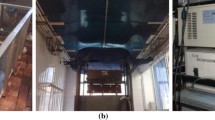Abstract
A full-scale landslide experiment was conducted to clarify the failure process of a landslide triggered by rainfall, using a loose sandy soil. The experiment used a 23-m long and about 8-m high flume, consisting of three parts: an upper 30° slope section, a lower 10° slope section, and a horizontal section at the foot of the slope. The flume was sprinkled at a constant intensity of 100 mm/h. The landslide occurred first in the upper slope about 154 min after the sprinkling started, following a creep movement within 41 min. The sliding mass slid to a stop in about 5 s, compressing soils in the lower gentle slope and horizontal sections. The dynamic process related to slide movement and the fluctuation of subsurface water pressures during failure were measured and analyzed. Sequential visual observations provided a clear record of the slip surface during failure. The rapid increase of subsurface water pressure in the slope and horizontal soil layers was also recorded during failure. It was inferred that the increased water pressures in the upper slope resulted from collapse of loose soil structure during shearing in the translational slide, whereas those in the lower portion of the slope and horizontal sections resulted from a mix of soil compression and shearing by the sliding mass.





















Similar content being viewed by others
References
Eckersley JD (1990) Instrumented laboratory flowslides. Géotechnique 40(3):489–502
Harp EL, Wells WG, Sarmients JG (1990) Pore-pressure response during failure in soils. Geol Soc Am Bull 102:428–438
Iverson RM (1997) The physics of debris flows. Rev Geophys 35(3):245–296
Iverson RM, LaHusen RG (1989) Dynamic pore-pressure fluctuations in rapidly shearing granular materials. Science 246:796–799
Iverson RM, Reid ME, LaHusen RG (1997) Debris-flow mobilization from landslides. Annu Rev Earth Planet Sci 25:85--138
Iverson RM, Reid ME, Iverson NR, LaHusen RG, Logan M, Mann JE, Brien DL (2000) Acute sensitivity of landslide rates to initial soil porosity. Science 290:513–516
Mogami T (1969) Soil mechanics (in Japanese). Gihoudo
Moriwaki H (1993) Behavior of pore-water pressure at slope failure. Proceedings of the seventh International Conference and Field Workshop on Landslides in Czech and Slovak Republics. Landslides, Balkema, Rotterdam, pp 263–268
Moriwaki H (2001) A risk evaluation of landslides in use of critical surface displacement (in Japanese with English abstract). Landslide: J Jpn Landslide Soc 38(2):115–127
Moriwaki H, Sato T (1998) Motion and fluidization of a Hariharagawa landslide, south Japan. Proceedings of International Union of Forest Research Organization 8 Conference, Environmental Forest Science, Kluwer, Dordrecht, pp 569–574
Okuda S (1984) Features of debris deposits of large slope failures investigated from historical records (in Japanese with English abstract). Annual report of Disaster Prevention Research Institute, Kyoto University, no 27 B-1, pp 353–368
Okura Y, Kitahara H, Ochiai H, Sammori T, Kawanami T (2002) Landslide fluidization process by flume experiment. Eng Geol 66:65–78
Reid ME, Lahusen RG, Iverson RM (1997) Debris-flow initiation experiments using diverse hydrologic triggers. Proc ASCE, First International Conference on Debris-Flow Hazards Mitigation: Mechanics, Prediction, and Assessment, pp 1–11
Sassa K (1998) Mechanisms of landslide-triggered debris flows. Keynote Lecture for the IUFRO (International Union of Forestry Research Organization) Division 8 Conference, Environmental Forest Science, Forestry Science, Kluwer, Dordrecht, vol 54, pp 499–518
Sassa K (2000) Mechanism of flows in granular soils. Invited paper. Proc. GeoEng2000, Melbourne, vol 1, pp 1671–1702
Spence KJ, Guymer I (1997) Small-scale laboratory flowslides. Géotechnique 47(5):915–932
Takahashi T (1991) Debris flow. Balkema, Rotterdam
Wang G, Sassa K (2003) Pore-pressure generation and movement of rainfall-induced landslides: effects of grain size and fine-particle content. Eng Geol 69:109–125
Yagi N, Yatabe R, Enoki M (1985) Laboratory and field experiments on prediction method of occurring time of slope failure due to rainfall (in Japanese with English abstract). Landslide: J Jpn Landslide Soc 22(2):1–7
Acknowledgements
The first author would like to thank Mr Sasaki Y and Mr Kogure T, graduate students of the University of Tsukuba, for their help in conducting these experiments and for processing the data. The APERIF Project of the Outlays for Promoting Science and Technology of the Ministry of Education, Culture, Sports, Science and Technology of Japan (MEXT) supported this research. Dr R.M. Iverson and Dr M.E Reid, US Geological Survey, are greatly thanked for their constructive comments that helped sharpen this paper.
Author information
Authors and Affiliations
Corresponding author
Rights and permissions
About this article
Cite this article
Moriwaki, H., Inokuchi, T., Hattanji, T. et al. Failure processes in a full-scale landslide experiment using a rainfall simulator. Landslides 1, 277–288 (2004). https://doi.org/10.1007/s10346-004-0034-0
Received:
Accepted:
Published:
Issue Date:
DOI: https://doi.org/10.1007/s10346-004-0034-0




